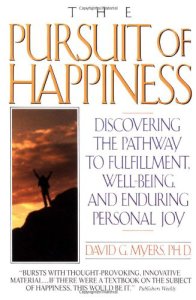By David G. Meyers, Ph.D. Avon Books. 1992.
Chapter 2: Wealth and Well-Being
Compared to 1957, we now have twice as many cars per capita. We have color TVs, VCRs, home computers, air-conditioners, microwave ovens, garage door openers, answering machines, and $12 billion a year worth of brand-name athletic shoes.
…
In 1990, as in 1957, only one in three Americans told the University of Chicago’s National Opinion Research Center they were “very happy.” So: We’re twice as rich–not just 20 percent richer–yet we’re no happier.
So, whether we base our conclusions on self-reported happiness, rates of depression, or teen problems, our becoming much better-off over the last thirty years has not been accompanied by one iota of increased happiness and life satisfaction. It’s shocking, because it contradicts our society’s materialistic assumptions, but how can we ignore the hard truth: Once beyond poverty, further economic growth does not appreciably improve human morale. Making more money–that aim of so many graduates and other American dreamers in the 1980s–does not breed bliss.
Seneca observed nearly two thousand years ago that:
our forefathers…lived every jot as well as we, when they provided and dressed their own meat with their own hands, lodged upon the ground and were not as yet come to the vanity of gold and gems…which may serve to show us, that it is the mind, and not the sum, that makes any person rich….No one can be poor that has enough, nor rich, that covets more than he has.
Chapter 4: The Demography of Happiness
The fact is that most men in their early forties exhibit no dip in their sense of well-being. What’s more, there is no upswing in job and marital dissatisfaction, career change, divorce, anxiety, depression, or suicide. Divorce, for example, is most common among those in their twenties, suicide among those in their seventies and eighties.
Other researchers have reached the same definite conclusion: Those tendencies that should be discernible, given a midlife crisis, are just not to be found–not even a midlife blip on the trend lines. Contrary to the empty nest and midlife myths, it is not age that marks the transitions from one life stage to another, but significant life events. Whenever they occur, childbearing, child leaving, relocation, occupational shifts, divorce, illness, retirement, and widowhood can recast our lives.
Chapter 8: The Friendship Factor
Asked ‘What is necessary for your happiness?’ or ‘What is it that makes your life meaningful?’ most people, however, mention–before anything else–satisfying close relationships with family, friends, or romantic partners.
In 1940, 8 percent of all U.S. households were composed of one person living alone. By 1988 the proportion had tripled to 24 percent. Today, people marry later, divorce more often, and live more of their lives independently, all leading to increased social isolation.
The most satisfying relationships are intimate. They enable us to be known and accepted as we truly are. A friend is someone with whom you feel comfortable being yourself. When trust displaces anxiety we become free to open ourselves without fear of losing the other’s affection. Such relationships are typified by high levels of what psychologists call self-disclosure.
The traffic between well-being and intimacy is two-way. Happiness promotes intimacy. In a good mood, we open up. In a bad mood, we clam up. And intimacy promotes happiness.
Lacking opportunities for self-disclosure–for sharing our likes and dislikes, our proud and shameful moments, our worries and dreams, our joys and sorrows–we are painfully lonely. Loneliness isn’t being alone. That’s solitude. It’s feeling alone, as one can even at a party. “I lie awake,’ ached the psalmist, feeling “like a lonely bird on the housetop.”
Disclosure begets disclosure. I reveal more to you if you have first been open with me. But intimacy is seldom instant. More often, we dance: I reveal a little, you reveal a little–but not too much; you then reveal more, and I reciprocate.
Chapter 10: Faith, Hope, and Joy
A vivid example of a close-knit religious community is Pennsylvania’s old order the Amish, a Protestant sect known for their agrarian, nonmaterialistic culture, their pacifism, and their self-sufficient communal life. Within this unified and supportive culture, major depression occurs about one fifth to one tenth as often as elsewhere in the United States.
This allows us to speculate that another part of what’s missing in today’s culture is a sense of meaning and purpose in living. The nineteenth-century Polish poet Cyprian Norwid wrote, “To be what is called happy, one should have (1) something to live on, (2) something to live for, (3) something to die for. The lack of one of these results in drama. The lack of two results in tragedy.”

